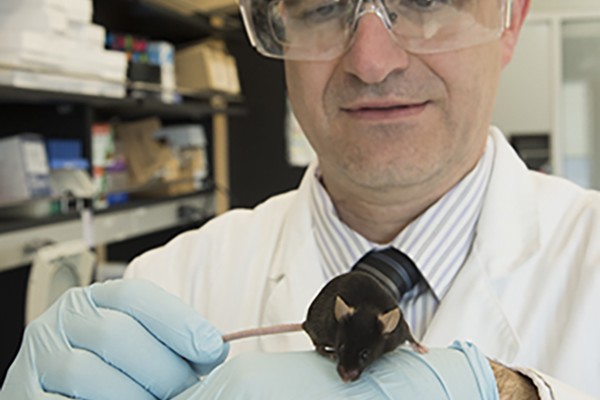Researchers at Washington University School of Medicine in St. Louis have identified a process in immune cells that links vitamin D deficiency during pregnancy to an increased risk of Type 2 diabetes in offspring. The researchers also found that these immune cells and their embedded genes can be used to transfer Type 2 diabetes into otherwise healthy mice.
The research is published June 13 in the journal Nature Communications.
Some theories of disease suggest that conditions in utero may have irreversible, lifelong consequences in offspring. The new study’s principal investigator, Carlos Bernal-Mizrachi, MD, said that could be happening to the children of mothers who don’t have adequate levels of vitamin D during pregnancy.
“The identification of modifiable, environmental risk factors that may contribute to the later development of metabolic diseases is critical to prevent and treat those diseases,” said Bernal-Mizrachi, a professor of medicine in the Division of Endocrinology, Metabolism & Lipid Research. “As the incidence of diabetes and prediabetes has tripled in recent decades, particularly in children and young adults, we are analyzing environmental conditions during pregnancy that may help explain the increase.”
About 37 million Americans have been diagnosed with diabetes, and at least 98 million more have prediabetes, a condition marked by the body’s resistance to insulin. Vitamin D deficiency during pregnancy, a deficiency that affects an estimated 80% of Black American women and 60% of Caucasian women, may be one of the factors contributing to insulin resistance and elevated risk for diabetes in offspring.
“In studies of mice born to vitamin D-deficient mothers, we have found that the animals go on to develop insulin resistance and diabetes later in life,” Bernal-Mizrachi said. “That was true even when pups were treated with adequate amounts of vitamin D after birth. Those animals improved their glucose control, but they never normalized.”
The researchers have identified a type of stem cell that may be irreversibly affected by vitamin D deficiency during development in utero. The stem cells develop into immune cells, and the researchers discovered that they could transplant diabetes into other animals by placing these stem cells into mice with normal vitamin D levels. The researchers concluded that insufficient levels of vitamin D in utero can program the immune cells to promote the development of diabetes, providing a target to potentially prevent this process.
In those experiments, the researchers found that the immune cells activated a genetic process that is the same such process activated in immune cells collected from delivering mothers who had insufficient vitamin D levels when they gave birth.
Although prenatal vitamins are prescribed to ensure adequate levels of key nutrients during pregnancy, these findings from Bernal-Mizarachi and his colleagues suggest that the recommended doses of vitamin D are not sufficient to normalize vitamin D levels in women who had low vitamin D levels prior to pregnancy.
The process the researchers identified in mouse fetuses was characterized by alterations in specific genes. The modified gene program was identified in the stem cells that later developed into immune cells, including macrophages. The research team discovered that these macrophages secrete a molecule that impairs the ability of fat tissue to store glucose, resulting in increased blood sugar levels.
“Macrophages that come from vitamin D-deficient stem cells get into the fat tissue and contribute to inflammation, causing the fat tissue to become insulin resistant,” said Bernal-Mizrachi, who also is chief of medicine at the Veterans Affairs St. Louis Health Care System.
Importantly, the researchers found evidence that the same processes that promote inflammation and insulin resistance in fat tissue also are at work in people. Immune cells isolated from cord blood from vitamin D-deficient pregnant patients who were cared for by physicians at Washington University showed similar changes in immune cell genes and secreted molecules that had been identified previously in mice.
Oh, Jisu, Riek AE, Bauerle KT, Dusso A, McNarney KP, Barve RA, Darwech I, Sprague J, Moynihan C, Zhang RM, Kutz G, Wang T, Xing X, Li D, Mrad M, Wigge NM, Castelblanco E, Collin Z, Bambouskova M, Head RD, Sands MS, Bernal-Mizrachi C. Embryonic vitamin D deficiency programs hematopoietic stem cells to induce type 2 diabetes. Nature Communications, June 13, 2023.
The study was funded with support from a VA Merit Award 1BX003648-01 and by the National Heart, Lung, and Blood Institute and the National Institute of Diabetes and Digestive and Kidney Diseases of the National Institutes of Health (NIH). Grant numbers: R01 HL094818, P30 DK020579 and UL1 TR002345. Additional funding was provided by the Children’s Discovery Institute.
About Washington University School of Medicine
WashU Medicine is a global leader in academic medicine, including biomedical research, patient care and educational programs with 2,800 faculty. Its National Institutes of Health (NIH) research funding portfolio is the third largest among U.S. medical schools, has grown 52% in the last six years, and, together with institutional investment, WashU Medicine commits well over $1 billion annually to basic and clinical research innovation and training. Its faculty practice is consistently within the top five in the country, with more than 1,800 faculty physicians practicing at 65 locations and who are also the medical staffs of Barnes-Jewish and St. Louis Children’s hospitals of BJC HealthCare. WashU Medicine has a storied history in MD/PhD training, recently dedicated $100 million to scholarships and curriculum renewal for its medical students, and is home to top-notch training programs in every medical subspecialty as well as physical therapy, occupational therapy, and audiology and communications sciences.



